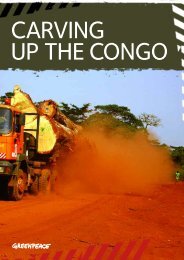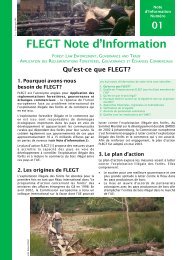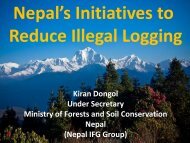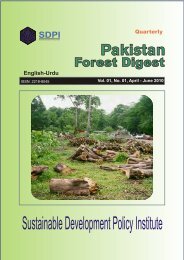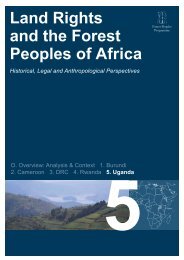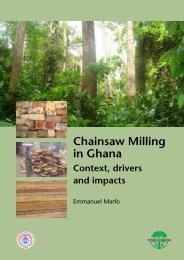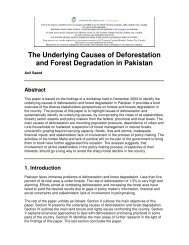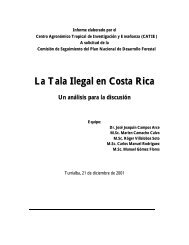conflict over natural resources at the community level in nepal
conflict over natural resources at the community level in nepal
conflict over natural resources at the community level in nepal
You also want an ePaper? Increase the reach of your titles
YUMPU automatically turns print PDFs into web optimized ePapers that Google loves.
5. Forest Management and Biodiversity Conserv<strong>at</strong>ion Disruption: The g<strong>over</strong>nment’s ability to enforceforest management laws and protect wildlife and o<strong>the</strong>r biodiversity <strong>resources</strong> with<strong>in</strong> and outsideprotected areas has been gre<strong>at</strong>ly reduced as a result of <strong>the</strong> armed <strong>conflict</strong>, putt<strong>in</strong>g <strong>the</strong>se <strong>resources</strong> <strong>at</strong> risk.This management vacuum has led to acceler<strong>at</strong>ed forest degrad<strong>at</strong>ion <strong>in</strong> <strong>the</strong> Terai and <strong>in</strong>creased poach<strong>in</strong>gof some wildlife species.3.3 NATURAL RESOURCES CONFLICT SCENARIOS3.3.1 Type I ConflictMaoist use of <strong>n<strong>at</strong>ural</strong> <strong>resources</strong> to fund <strong>the</strong>ir military oper<strong>at</strong>ions seems to vary widely <strong>in</strong> different parts of <strong>the</strong>country and <strong>over</strong> time. They have shown <strong>the</strong>mselves to be opportunistic, obta<strong>in</strong><strong>in</strong>g funds from wh<strong>at</strong>eversources are <strong>at</strong> hand. Early <strong>in</strong> <strong>the</strong> <strong>in</strong>surgency, <strong>the</strong>y robbed banks to get cash. Over <strong>the</strong> past decade <strong>the</strong>y haveset up systems for levy<strong>in</strong>g taxes on salaries and extort<strong>in</strong>g money from bus<strong>in</strong>esses. We do not know wh<strong>at</strong>percentage of <strong>the</strong>ir total fund<strong>in</strong>g comes from <strong>the</strong> various ways of “tax<strong>in</strong>g” <strong>n<strong>at</strong>ural</strong> resource use listed below.For some Maoist units, especially those <strong>in</strong> <strong>the</strong> high mounta<strong>in</strong>s and along <strong>the</strong> border with India, taxes onNTFPs and timber, respectively, may provide a significant portion of <strong>the</strong>ir fund<strong>in</strong>g.• The Maoists tax timber harvested by <strong>community</strong> forest groups and g<strong>over</strong>nment-appo<strong>in</strong>ted logg<strong>in</strong>gcontractors. Community forestry products are reportedly taxed from 2 to 50% with Terai timber mos<strong>the</strong>avily taxed.• The Maoists tax collectors and traders of medic<strong>in</strong>al and arom<strong>at</strong>ic plants and o<strong>the</strong>r NTFPs.• The Maoists charge foreigners visitor fees for enter<strong>in</strong>g <strong>at</strong> least two n<strong>at</strong>ional parks and also extort moneyfrom trekk<strong>in</strong>g oper<strong>at</strong>ors and hotels.• The Maoists are believed to profit <strong>in</strong> some way from wildlife poach<strong>in</strong>g, ei<strong>the</strong>r by tax<strong>in</strong>g <strong>the</strong> poachers or<strong>the</strong> traders.• The Maoists tax larger landowners as a percentage of <strong>the</strong>ir crop from irrig<strong>at</strong>ed land and <strong>in</strong> some caseshave displaced landlords and taken a portion of <strong>the</strong> harvest of sharecroppers.• Maoists have taxed some hydropower systems and have sabotaged o<strong>the</strong>rs.3.3.2 Type II ConflictCompetition <strong>over</strong> <strong>n<strong>at</strong>ural</strong> <strong>resources</strong> <strong>at</strong> <strong>the</strong> <strong>community</strong> <strong>level</strong> is deeply embedded <strong>in</strong> Nepalese history andsociety as discussed <strong>in</strong> Section 2. This <strong>conflict</strong> is chronic but generally not violent. The Maoists and <strong>the</strong>ir warwith <strong>the</strong> RNA has changed <strong>the</strong> social and g<strong>over</strong>nance framework with<strong>in</strong> which <strong>n<strong>at</strong>ural</strong> resource <strong>conflict</strong>occurs <strong>in</strong> ways th<strong>at</strong> can be bad, good, or neutral for <strong>the</strong> poorest users and <strong>the</strong> <strong>resources</strong> <strong>the</strong>mselves. N<strong>at</strong>uralresource <strong>conflict</strong> under <strong>the</strong> <strong>in</strong>surgency cont<strong>in</strong>ues to be largely non-violent, except <strong>in</strong> cases where <strong>the</strong> Maoistshave killed forestry and park guards or both sides have killed <strong>in</strong>nocent Nepalis for enter<strong>in</strong>g forested areas.Terai Forests• Anecdotal evidence <strong>in</strong>dic<strong>at</strong>es th<strong>at</strong> <strong>the</strong>re have been clashes between armed timber smugglers from Indiaand Maoist forces <strong>over</strong> control of <strong>the</strong> illegal timber trade <strong>in</strong> <strong>the</strong> Terai.• There have been <strong>conflict</strong>s <strong>over</strong> forest <strong>resources</strong> <strong>in</strong> g<strong>over</strong>nment-owned forests <strong>in</strong> <strong>the</strong> Terai betweenadjacent communities or with distant users. These <strong>in</strong>ter-<strong>community</strong> <strong>conflict</strong>s are generally not violent.• Internally Displaced Persons (IDPs) from <strong>the</strong> hills have illegally settled on forest est<strong>at</strong>e lands <strong>in</strong> <strong>the</strong>western Terai. This implicit <strong>conflict</strong> with <strong>the</strong> g<strong>over</strong>nment is reported to <strong>in</strong>volve tens of thousands ofpeople.12 CONFLICT OVER NATURAL RESOURCES AT THE COMMUNITY LEVEL IN NEPAL




